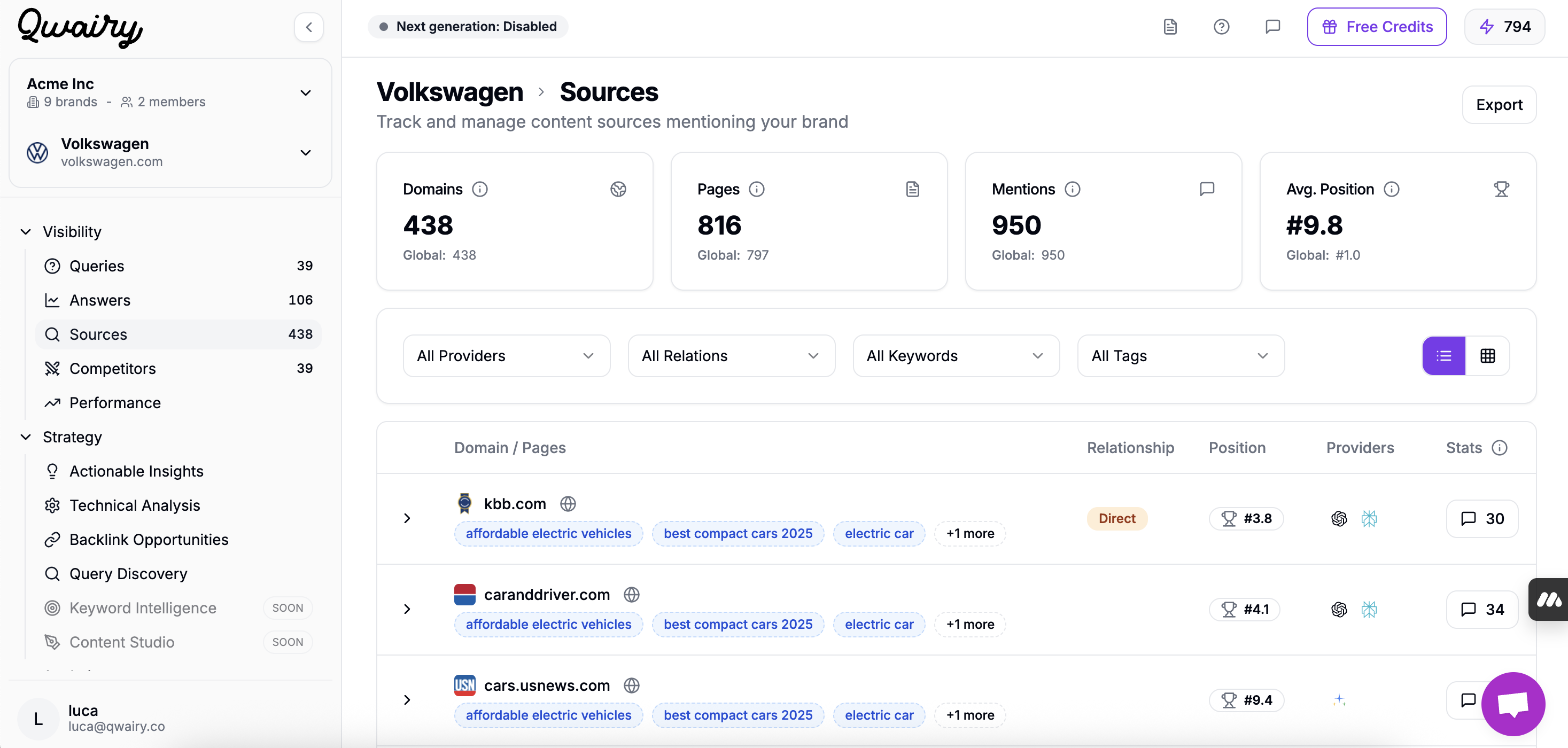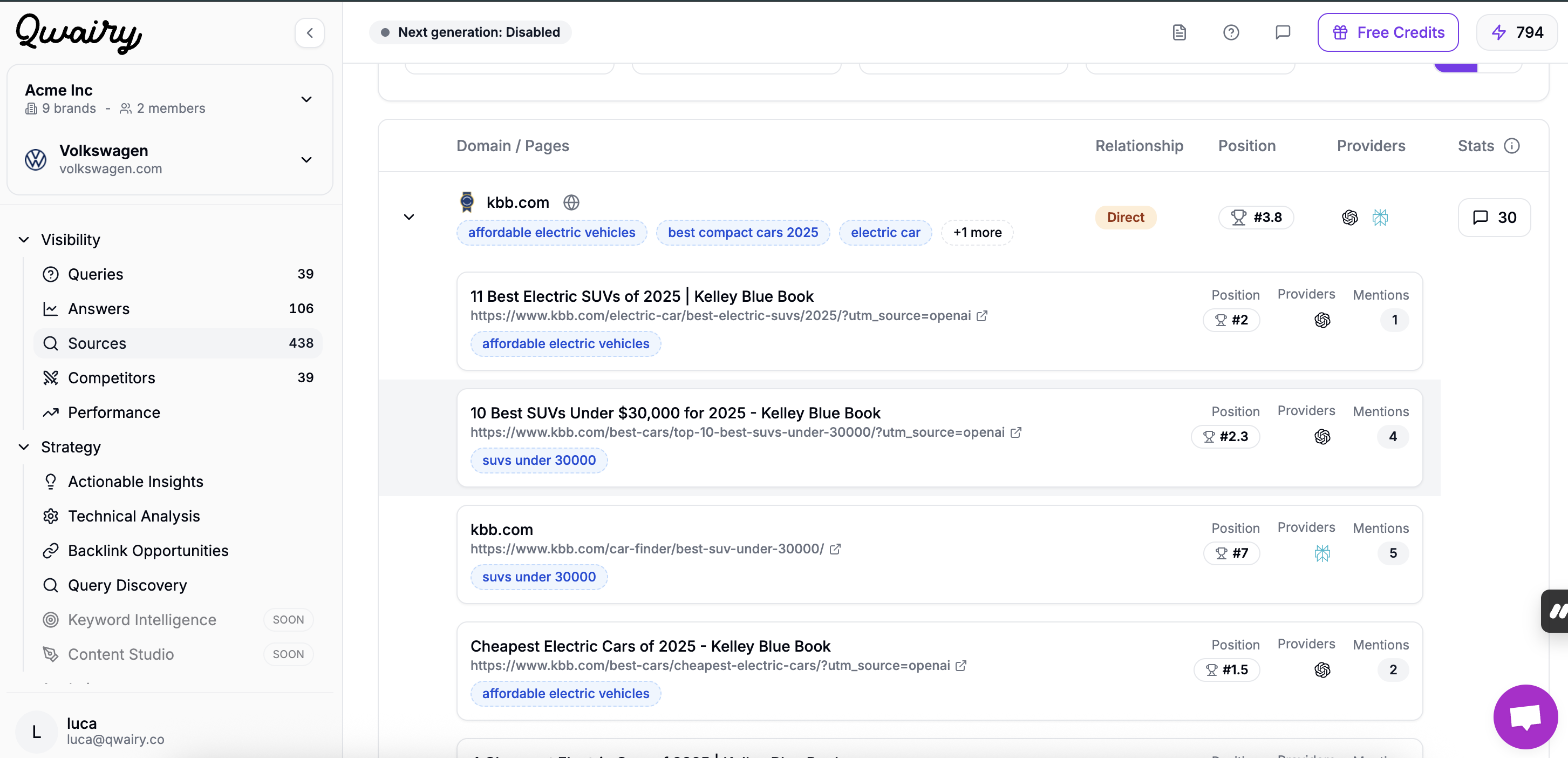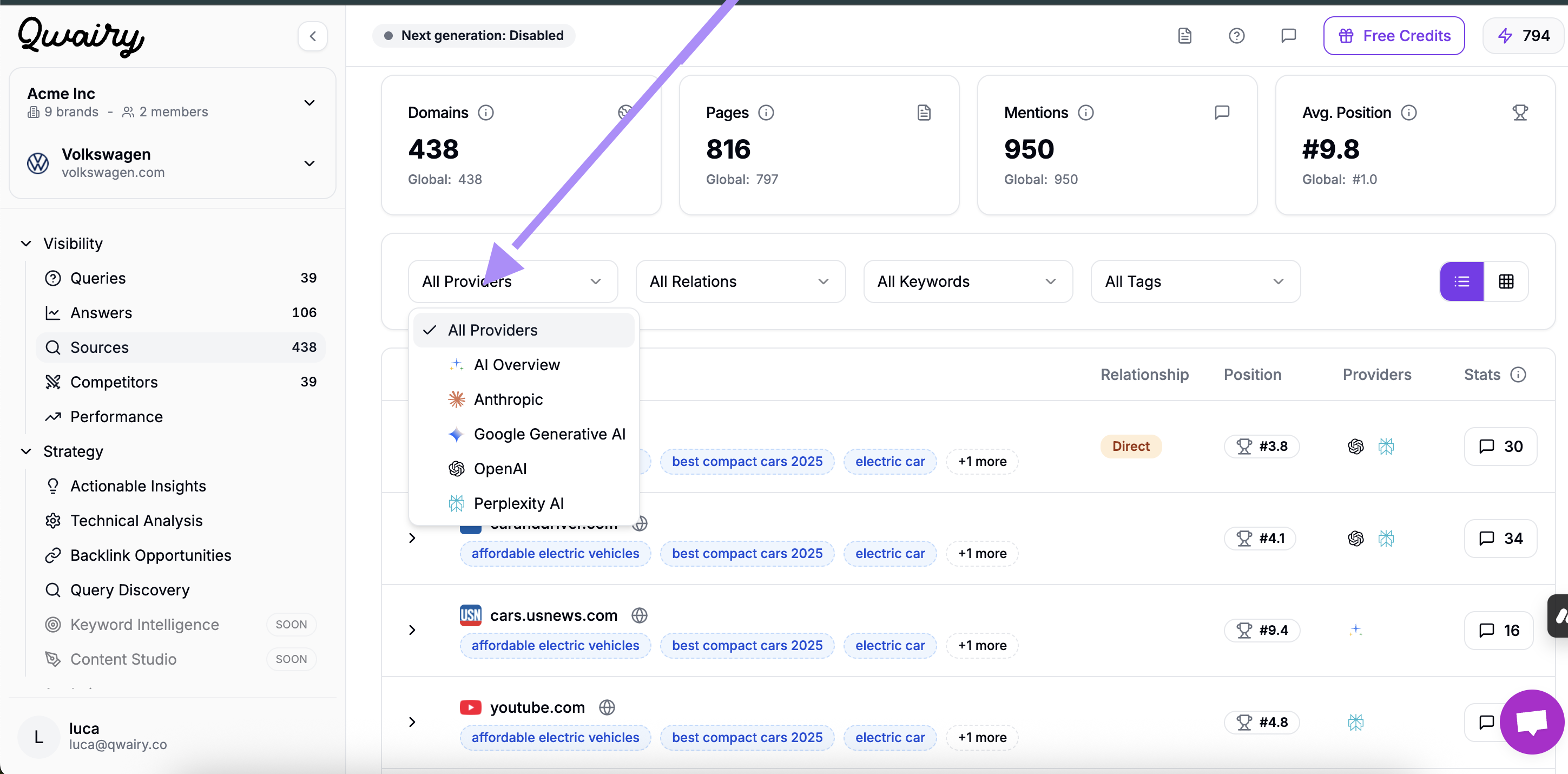Skip to main content
1. Introduction: Why Sources Matter
In Qwairy, “sources” represent the original web domains and pages that Large Language Models (LLMs) reference when generating answers that mention your brand. These could be anything from editorial reviews and blog posts to comparison articles, directories, and even your own website.
Understanding your source landscape is essential because LLMs don’t generate brand visibility out of thin air — they rely on published, high-quality web content to formulate answers. That means if your brand is mentioned (positively or negatively) in a well-ranked source, it can dramatically influence how LLMs describe you.
🧠 Why it matters:
If you’re present on high-authority, frequently cited websites, you increase your chances of showing up in trusted, top-ranked AI answers. On the other hand, weak or missing coverage can mean you’re invisible — even if your product is excellent.
The Citation Sources dashboard in Qwairy lets you track exactly where you appear, how often you’re mentioned, and how visible you are across different AI providers. It’s not just about presence — it’s about influence, quality, and strategic opportunity.
2. Understanding the Citation Sources Dashboard
The Citation Sources dashboard gives you a detailed, page-by-page view of the content that powers your brand’s visibility across AI answers. It’s broken down into several core metrics and filters to help you identify where you’re strong, where you’re missing, and where to act.
📦 Key Metrics at a Glance
 At the top of the page, you’ll see four essential indicators:
At the top of the page, you’ll see four essential indicators:
- Domains: The number of unique websites referenced in LLM answers.
- Pages: Total number of individual pages (URLs) detected in AI responses.
- Mentions: Number of time sources are referenced in answers.
- Average Position: Your brand’s average position in AI-generated answers when these sources are cited.
These KPIs help you measure the breadth, depth, and prominence of your source-based visibility.
📄 Table Breakdown: Source-Level Detail
Each row in the table represents a domain (e.g., kbb.com, caranddriver.com) with expandable detail on individual pages.
 Here’s what you’ll find:
Here’s what you’ll find:
- Domain / Pages: Shows which source websites are most influential, and which specific articles or content pieces are referenced.
- Keywords: Associated queries (e.g., electric car, best compact cars 2025) that triggered the citation.
- Position: The average position your brand holds when that source is cited.
- Providers: AI models that referenced the source (e.g., OpenAI, Perplexity).
- Stats: How many mentions are tied to that page in total.
💡 Tip: Click the dropdown on any domain to explore every page, along with detailed mention and ranking data.
Filters for Granular Analysis
The dashboard offers powerful filters that allow you to slice the data precisely:

- By Provider: See how different LLMs (e.g., OpenAI, Perplexity, Anthropic) are leveraging various sources.
- By Keyword: Focus on topic-specific visibility (e.g., affordable electric vehicles vs suvs under 30000).
- By Tags (if used): Segment content based on custom organizational tags.
This granularity helps you move from passive observation to strategic action.
🔗 Next Step: Some of these sources — especially those that don’t yet link to you — can be turned into backlink opportunities. You’ll find these flagged in the Strategy > Backlink Opportunities section.
3. Provider-Level Analysis: See Which Models Cite Which Sources
Not all AI models rely on the same sources when generating answers. In fact, each provider (like OpenAI, Perplexity, Gemini, or Claude) has its own way of interpreting and referencing information. That’s why Qwairy lets you break down source impact by LLM provider.
Why this matters
- Some providers favor live web data (e.g., Perplexity, AI Overview)
- Others rely more on training data and structured knowledge (e.g., OpenAI, Claude)
- A source that performs well on one model may be completely ignored by another
🔍 Example:
A page on caranddriver.com may be frequently cited by Perplexity, but not appear at all in OpenAI results — even if the brand is mentioned.
This view helps you understand how your content and external coverage performs per model, allowing you to adapt your strategy accordingly.
How to use it
- Use the Provider filter at the top of the Citation Sources dashboard to isolate results by model.
- Each row in the table shows which providers cited a source, using their respective icons.
- You can combine this with keyword filters to get ultra-granular insights (e.g., what Perplexity cites on “hybrid vehicles”).
💡 Pro Tip: If you’re seeing strong presence in one model but gaps in another, adjust yourpublication channels to better align with that model’s behavior.
5. Keyword-Level Analysis: Understand Source Impact by Topic
Qwairy allows you to filter sources by keyword, so you can see which websites and pages influence your brand’s visibility on specific topics, not just in general. This is crucial for aligning your AI visibility with your business priorities.
Why this matters
You don’t just want to show up somewhere — you want to show up on the right topics.
- A source might dominate for “electric vehicles” but be irrelevant for “SUVs under 30k”.
- You might be well-cited on brand-related queries but absent from category-level ones.
- You can uncover topic-specific opportunities or gaps at the source level.
🔍 Example:
If usnews.com is cited often as a source on queries about “safe family cars” and your brand isn’t mentioned there, you’ve found a strategic content opportunity.
How to use it
- In the Citation Sources dashboard, use the Keyword filter to focus on a specific query theme.
- The table will update to show only the domains and pages that appear in answers triggered by that keyword group.
- You can combine this with the Provider filter for maximum precision (e.g., how OpenAI handles “compact EVs”).
💡 Pro Tip: Use this filter regularly to track whether your content and media coverage aligns with your core business topics, not just brand name mentions.




